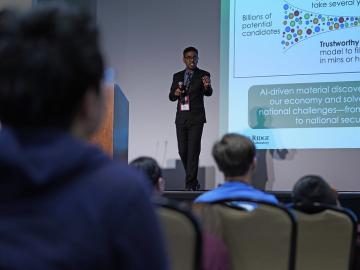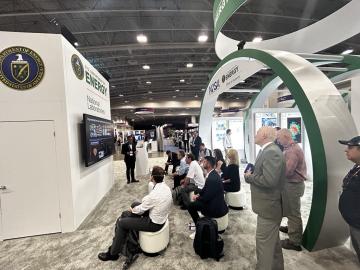
Filter News
Area of Research
- Advanced Manufacturing (3)
- Biology and Environment (28)
- Clean Energy (75)
- Computational Biology (2)
- Computational Engineering (1)
- Computer Science (5)
- Fusion and Fission (5)
- Isotopes (3)
- Materials (48)
- Materials for Computing (11)
- National Security (18)
- Neutron Science (15)
- Nuclear Science and Technology (3)
- Quantum information Science (3)
- Supercomputing (59)
- Transportation Systems (2)
News Type
News Topics
- (-) Artificial Intelligence (62)
- (-) Composites (18)
- (-) Cybersecurity (17)
- (-) Exascale Computing (27)
- (-) High-Performance Computing (55)
- (-) Microscopy (34)
- (-) Nanotechnology (32)
- (-) Polymers (20)
- (-) Security (13)
- (-) Space Exploration (22)
- (-) Transportation (67)
- 3-D Printing/Advanced Manufacturing (76)
- Advanced Reactors (22)
- Big Data (46)
- Bioenergy (68)
- Biology (79)
- Biomedical (41)
- Biotechnology (15)
- Buildings (43)
- Chemical Sciences (37)
- Clean Water (28)
- Climate Change (76)
- Computer Science (131)
- Coronavirus (29)
- Critical Materials (16)
- Decarbonization (59)
- Education (1)
- Emergency (2)
- Energy Storage (66)
- Environment (153)
- Fossil Energy (5)
- Frontier (26)
- Fusion (42)
- Grid (48)
- Hydropower (11)
- Irradiation (2)
- Isotopes (33)
- ITER (5)
- Machine Learning (34)
- Materials (79)
- Materials Science (88)
- Mathematics (9)
- Mercury (10)
- Microelectronics (2)
- Molten Salt (6)
- National Security (45)
- Net Zero (10)
- Neutron Science (77)
- Nuclear Energy (79)
- Partnerships (19)
- Physics (38)
- Quantum Computing (25)
- Quantum Science (41)
- Renewable Energy (1)
- Simulation (39)
- Software (1)
- Statistics (2)
- Summit (36)
- Sustainable Energy (95)
- Transformational Challenge Reactor (3)
Media Contacts

Two ORNL teams recently completed Cohort 18 of Energy I-Corps, an immersive two-month training program where the scientists define their technology’s value propositions, conduct stakeholder discovery interviews and develop viable market pathways.

Researchers at the Department of Energy’s Oak Ridge National Laboratory and partner institutions have launched a project to develop an innovative suite of tools that will employ machine learning algorithms for more effective cybersecurity analysis of the U.S. power grid.

Brittany Rodriguez never imagined she would pursue a science career at a Department of Energy national laboratory. However, after some encouraging words from her mother, input from key mentors at the University of Texas Rio Grande Valley, or UTRGV, and a lot of hard work, Rodriguez landed at DOE’s Manufacturing Demonstration Facility, or MDF, at Oak Ridge National Laboratory.

Researchers conduct largest, most accurate molecular dynamics simulations to date of two million correlated electrons using Frontier, the world’s fastest supercomputer. The simulation, which exceed an exaflop using full double precision, is 1,000 times greater in size and speed than any quantum chemistry simulation of it's kind.

In the wet, muddy places where America’s rivers and lands meet the sea, scientists from the Department of Energy’s Oak Ridge National Laboratory are unearthing clues to better understand how these vital landscapes are evolving under climate change.

Researchers at ORNL and the University of Maine have designed and 3D-printed a single-piece, recyclable natural-material floor panel tested to be strong enough to replace construction materials like steel.

Prasanna Balaprakash, a national leader in artificial intelligence, or AI, spoke to some of the highest achieving students in the country at the National Science Bowl in Washington D.C.

ORNL researchers and communications specialists took part in the inaugural AI Expo for National Competitiveness in Washington D.C, May 7 and 8, to showcase and provide insight into how the lab is leading the way for utilizing the vast possibilities of AI.

Oak Ridge National Laboratory scientists ingeniously created a sustainable, soft material by combining rubber with woody reinforcements and incorporating “smart” linkages between the components that unlock on demand.

John Lagergren, a staff scientist in Oak Ridge National Laboratory’s Plant Systems Biology group, is using his expertise in applied math and machine learning to develop neural networks to quickly analyze the vast amounts of data on plant traits amassed at ORNL’s Advanced Plant Phenotyping Laboratory.


